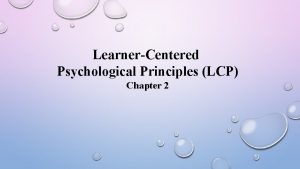Metacognitive Awareness and Judgments of Learning in Statistics

- Slides: 1

Metacognitive Awareness and Judgments of Learning in Statistics Courses Erin M. Buchanan, Katherine D. Miller, Emily R. Klug, and the DOOM Lab Missouri State University Judgments of Learning (JOLs) are included in the field of metacognitive research. This field is rich in terms of defining what and how students make JOLs, but is lacking in terms of understanding these judgments in the scope of domain specificity. The understanding of JOLs in statistics, both in declarative (fact-based questions) and procedural (skills based questions) knowledge, needs to be expanded upon. We hypothesized that metacognitive awareness, GPA, and previous statistical experience will be significant covariates of the relationship between JOL and test performance. Additionally, it is believed that there will be a significant difference in JOLs on types of knowledge, and we expected that JOLs will change across the semester. Method Participants 77 participants from three different statistics courses at our university were used. Students’ ages typically range from 18 -26, and they represent a number of different majors on campus. Two undergraduate classes were sampled, one of them with 27 students enrolled and the other with 18 students. In addition to these courses, one statistics class was incorporated that included both undergraduate and graduate students, with 32 students involved. Procedure • Before each exam, students were asked to make JOLs on both declarative and procedural information. • “How well do you think you’ll do on the facts portion of this exam? ” and “How well do you think you’ll do on the skills portion of this exam? ” • Fact questions were defined as containing theoretical concepts, while the skills portion of the exam consisted of questions that asked them to apply that knowledge. • Facts: Why do people use hypothesis testing? What is the main goal of the procedure? • Skills: Create a graph that displays the results of the differences between left and right-handers on word ratings. • At the conclusion of the course, a modified version of the SEMLI-S (Thomas, Anderson, & Nahson, 2008; excluding the science specific questions) was administered to measure their metacognitive awareness. Analysis • A multilevel model controlling for correlated error of participant and item was used to analyze the data. • Independent variables included previous GPA (student aptitude), previous experience with statistical skills (expertise), JOL type (facts/skills), exam time, the SEMLI-S, and their interaction with JOL ratings. • Item scores for each exam were considered the dependent variable. Average Item Scores on Fact and Skills Based Questions Results Abstract Main Effects Predictor GPA Question Type Rating Expertise Exam Time Concentration Risks Self Efficacy Monitoring b (SE) 0. 10 (0. 04) -0. 07 (0. 01) 0. 51 (0. 04) 0. 02 (0. 05) -0. 03 (0. 005) 0. 03 (0. 06) -0. 09 (0. 08) 0. 09 (0. 04) 0. 001 (0. 06) t 2. 57 -7. 57 12. 34 0. 50 -7. 14 0. 53 -1. 13 2. 26 0. 02 p. 01 <. 001. 62 <. 001. 60. 27. 03. 98 Note. The analyses including the top variables were performed on the full dataset, while the SEMLI-S was analyzed on available values. Main effects change slightly in magnitude, but not direction for the smaller SEMLI-S subset. Average JOL Ratings Interactions – Simple Slopes Group Low GPA Average GPA High GPA Facts Skills Exam 1 Exam 2 Exam 3 Exam 4 b (SE) 0. 86 (0. 52) 0. 77 (0. 48) t 1. 65 1. 61 p. 10. 11 pr. 26. 21 0. 68 (0. 44) 2. 61 (0. 74) 1. 08 (0. 74) 1. 71 (0. 82) -4. 36 (1. 55) 2. 41 (0. 95) -2. 80 (1. 30) 2. 86 3. 52 1. 45 2. 09 -2. 81 2. 55 -2. 15 . 12 <. 001. 15. 04 <. 01. 03 . 24. 33. 12. 23. 21. 35 Note. Interactions with expertise were not significant, along with the three-way interactions for any variables. The b values presented here are JOL rating to score. Because b values are difficult to interpret with all other variables, partial correlations are presented for comparison to traditional JOL gammas. Metacognitive Interactions (see handout for table) • As concentration skills were rated higher, lower JOL-score simple slopes were found. • Higher rated risks decreased simple slopes with lower JOLscore correlations • Higher rated monitoring skills indicated higher JOL-rating simple slopes. Discussion Several factors were related to JOLs and their accuracy in a classroom setting. This study attempted at looking at a few of those things; GPA, metacognitive awareness, and previous statistical experience, and further work should explore a diverse range of students and experiences to clarify the relationship between metacognition and statistical learning skills. Student aptitude, but not previous experience, showed a comparable JOL effect to previous studies (i. e. slope values in the. 20 -. 30 range). Students were more aligned in predicting their performance on facts questions, over skills questions. Course material (exam time) showed an interesting interaction on JOLs, as well as rated metacognitive skills. Contact: Dr. Erin M. Buchanan (erinbuchanan@missouristate. edu) Thanks: Jessica Willis for help with data entry and analysis.

